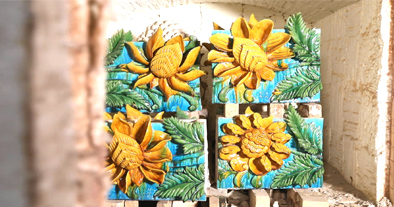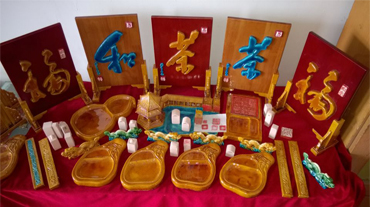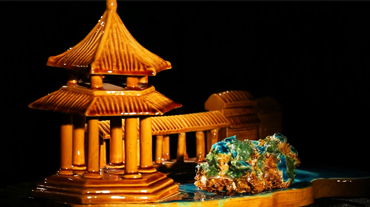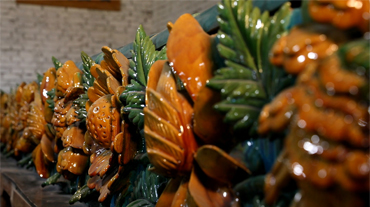In a small workhouse inside the Sarmizegetusa Regia citadel, in ancient Dacia, a Dacian craftsman meticulously forges clay pottery which he would later paint with floral patterns. Tens of thousands of miles away, in a different corner of the world, at the same time, a Chinese craftsman follows his technique in carving dragons and ornaments for the royal palace. Thousands of years later, in both sides of the world their work of art is discovered and studied. Fortunately, the techniques are not lost. There are still artisans who carry them on and enchant the world with beautiful objects reminding us of the old times or the modern demand.
The art of processing clay is one of humanity’s oldest occupations. Ceramic pieces have been found in a cave in the Hunan Province, China; experts say they are over 18.000 years old. But it seems that the hunters – rippers of Moravia had used such objects for the first time over 26.000 years ago! According to art history, the generic term refers to any dish created for practical or artistic purposes but also to all decorative objects with an only esthetic role. Such objects are obtained from inorganic materials (minerals) which become solid and sturdy through burning at very high temperatures, once they've been carved by the hands of a craftsman.
For all Romanians, black ceramics stands as testimony of the old Dacian times; presently, such ceramics is only being produced in a few Romanian workshops. Back then, the master would burn his work in big, deep, conic holes in the ground (with their beak up), which communicated through ditches with the smaller fire-holes. Nowadays, artists use well-heated ovens, with closed upper-parts and fire-holes; the dark color comes from the lack of oxygen during burning. Not only basic pottery has accompanied humanity throughout the ages, but also glazed tiles. The glazing technique involves the forming of a solid, glassy and insulating layer (like a glare coating) over the simple ceramic surface. Such pieces needed high temperatures to burn: 1.100 Celsius degrees, in a first stage; and then again, after the glazing, they would burn at 900 Celsius degrees.
The art of glazed tiles is archaic in China. The tiles were used as construction elements, for royal palaces and noble buildings. But the artists also created beautiful decorative figurines and objects using the same technique. Glazed tiles dating from the Han, Tang, Song, and Yuan dynasties have been discovered, but also from the times of the Ming and Qing dynasties when these objects were rather trendy. They were found in royal chambers of the palace in Beijing’s Forbidden City, in noble houses of high-officials and even in ceremonial temples – including the legendary Temple of Heaven. The colors which perfected those objects were yellow, green, blue or black; besides their elegant role, they also carried political meaning.
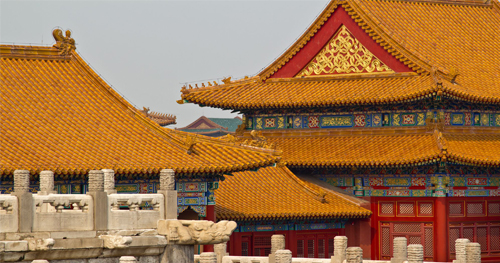
The Shanxi Province in China is famous for its glazed tiles; the craft has been continuously preserved here for over a thousand years, and many families have built their businesses and fortune on it. The coal mining industry in the area led to the appearance of a by-product – a sticky mud with low aluminum in it, which became the raw material for ceramics. The strong tradition of passing on the craft from one generation to another helped preserving the occupation. The Su family is such an example: they are one of the three oldest craftsmen families in Shanxi, and they've been keeping the tradition alive for over 680 years. They began producing glazed tiles in 1522, for the royal court under the Ming Dynasty.
Their story (almost seven centuries old) has gone through numerous hardships and changes. The evolution of society always leaves a mark on the development of early traditions and habits, on how they are being kept or reinvented, and on how they are perceived by the public and the market. A glazed tile, bearing the inscription “Mazhuang Shantou Su Style,” was discovered during the renovation work on Beijing’s mysterious Forbidden City. In 2007, the Chinese Ministry of Culture assigned a specialist with the task of documenting the Su-style of producing glazed tiles and visiting the family whose mark was found on the tile. He found that the family was still making tiles the traditional way, although the passing on of the technique from one generation to another hadn't exactly been “flat racing.” The leader of the 8th generation of the family, Su Yongjun, was working, at that time, in transportation, due to economic circumstances.
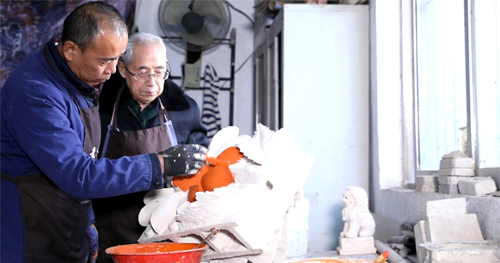
“As a child, I used to go to the factory with my grandfather to study, so this tradition has had a deep influence on me. My grandfather has always expected me to inherit the family business when the time would be right. But many factories in the region have closed because the excessive polluting they produced by using coal and wood for burning. That's how I got into transportation,” the 51-years-old man explains. Three months after the visit of the specialist appointed by the Ministry, he decided to invest in founding a new factory which would make glazed tiles again by using the Su-style developed by his ancestors, but without polluting the environment. He gave up wood and coal and went for gas and electricity. He implemented ecological keystones, and along with his father (Su Fugen), his grandfather ((Su Jie) and his teacher (Ge Yuansheng) he founded a new company: Taiyuan Shantou Peacock Blue Glazed works Co. Ltd.
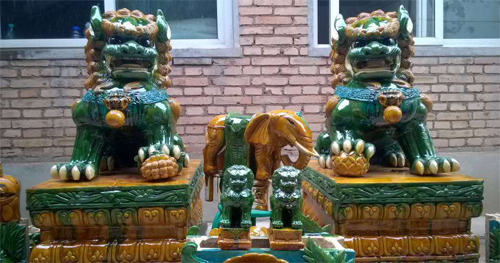
”One year later, in 2008, the Su glazing technique – representing the Shanxi’s glazing industry – has been included among the second batch national-level intangible cultural heritage list by the Ministry of Culture,” says Su Yongjun. But his difficult battle to reinvent the craft on sustainable principles had just started. The first step was going green. The second one was to recover the peacock blue color, the most beloved, appreciated and hard to obtain color in this industry. “I performed thousands of experiments. I gathered information; I gave up synthetic chemicals and worked only with minerals. I talked to the elders. For two year I just kept trying out. But we finally managed to recover the color!” says Su Yongjun proudly. His third business decision was to reject all orders for cheap products and to target the high-end markets with entirely handmade art objects. Now he aims to sell his work to hotels and significant real estate projects.
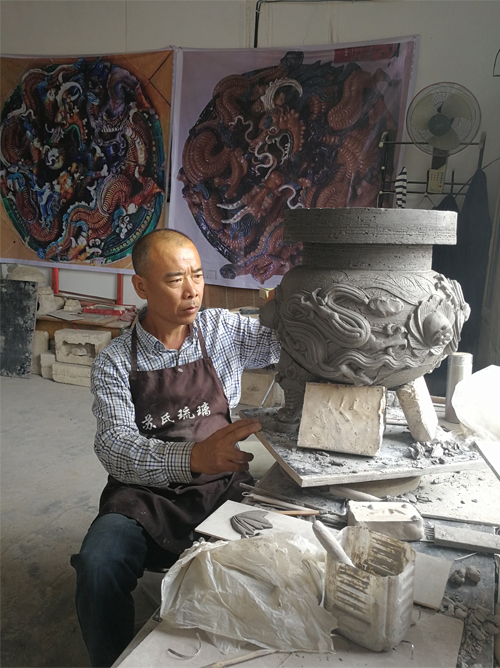
Both his sons work with him: Su Qi (25) and Su Wangsheng (21). Thus, four craftsmen generations work together, following a hundreds-years-old technique brought into the present. They create amazing, interesting objects, such as: Chinese calligraphic plaques, carved dragon walls, glazed stone lions, glazed carved floral bricks, glazed bonsai, glazed Buddha statues, glazed incense burners and various glazed souvenirs. Six family members are involved in this business, along with four relatives and other nine hired workers. The family also works with universities and schools; thus, 12 students will spend four months as interns at the Su factory. Every Saturday or Sunday, the Su family invites students from primary schools and middle schools to join them.
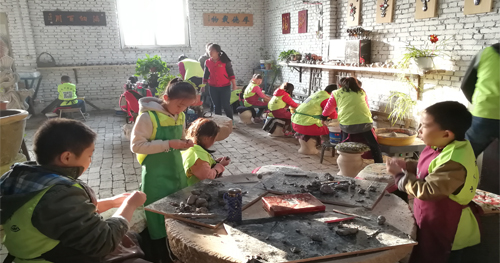
Such interest from the new generations towards ancient crafts is refreshing: it gives us hope that they won’t be lost. And it’s great to see that the artisans from nowadays think in ecologic terms and find green solutions for developing eco-friendly businesses. Turning our eyes from distant China into our backyard, we see the ceramic artist Dan Les in the city of Baia Sprie (Maramures County). He's an advocate and follower of the Dacian ceramic style and has preserved the old technique unaltered. He follows all the traditional steps, from carefully preparing the clay until the burning stage. The objects he creates are meant to be used day by day: plates, jars, cups, wine or water amphorae, lamps, etc. His work is very popular because it bears the symbol of preserving and keeping alive a traditional habit threatened by the wave of globalization.
The pottery artists from Radauti and Marginea, in Suceava County, also carry on the old Dacian tradition. Their work is famous for the floral or geometrical patterns in vivid colors – brown, green, yellow – on a red or white background. The ceramic art from Marginea, as well as the one from Corund, is internationally renowned. According to historians, the beginnings of the pottery tradition in Marginea date from the year 1500. One of the families keeping the craft for several generations is Colibaba: they have been making and selling ceramic products for over 200 years. The passing on of art is also a common practice in traditional Gypsy families – usually from father to son. For instance, the Gypsies from the social business “Meșteshukar Butiq” in Bucharest are silversmiths, blacksmiths, copper-smiths or braiders (with willow or hazel birches).
Thus, wherever we look, we can find proof showing us that certain traditions and occupations can endure the passing of time. Either kept unaltered or reinvented to suit the modern ages, they accompany us generation after generation as a constant reminder of the eternal, unique beauty of humanity's creative spirit.
Photos (China): BON Cloud
Photos (Romania): Matei Pleșa
